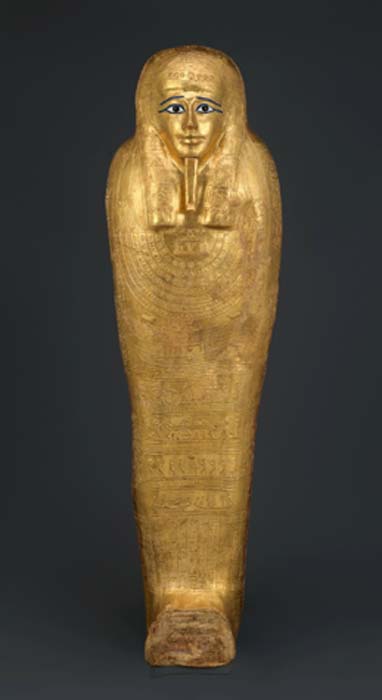New York Met Returns Stolen Golden Coffin to Egypt
In New York, authorities, have announced the return of a stolen gold coffin to Egypt. The coffin was fraudulently sold to the New York's Metropolitan Museum of Art. Its repatriation is another example of the growing international efforts to combat the black market in antiquities.
The coffin, which is in the shape of a mummy, is 6-foot-long (2 meters) and is skillfully made from wood and metal, being covered in sheets of gold. It belonged to a priest by the name of Nedjemankh and dates back to the first century BC when Egypt was ruled by the Ptolemaic Dynasty. He was a senior priest of the ram-god Heryshef of Herakleopolis. The coffin no longer contains the mummy of the priest.
The coffin of a priest
The golden coffin of Nedjemankh is “elaborately decorated with scenes and hieroglyphic texts meant to guide the priest on his journey to eternal life” reports CNN. The gold in the coffin symbolized the priest’s special relationship to the Egyptian gods. It was widely held that the gods were made of the precious metal. For example, the eyes of Heryshef were believed to be made of gold. A unique feature of the coffin is the thin layers of silver inside the casket, possibly designed to protect the face of the priest during his journey to the afterlife.

Lid of the ornate and skillfully created gold coffin is covered with hieroglyphs. (Metropolitan Museum of Art/ CC0)
The gold coffin was stolen in Egypt in 2011 when the country was in political and social turmoil. The BBC reports that “the grand and ornate coffin had been buried in the country's Minya region for 2,000 years before it was stolen”. It was smuggled out of the country first to the United Arab Emirates (UAE) and then to Germany. Here some restoration was undertaken on the casket before it was shipped to France. According to the Daily Mail, the New York Metropolitan Museum “purchased the coffin from a Paris art dealer in July 2017 for about $4 million”.
Forged documents
The museum believed that the art dealer, Christophe Kunicki, was acting in good faith and had a legal right to sell the coffin. However, the Daily Mail reports that the historic item was “sold with bogus documentation, including a forged 1971 Egyptian export license”. As a result, the museum was deceived into believing that they could legitimately purchase the golden coffin. The object was placed on public display and soon was a major hit with the public. In a short period of time, around 500,000 people came to see the beautiful coffin, which is in remarkable condition.
- Mummy À La Mode: Elaborate Treatment of the Square-Faced Mummy with Intricate Décor
- Egyptian Hieroglyphs: The Language of the Gods
- The Lost City of Thinis, First Capital of a United Egypt

Lid of the coffin of Nedjemankh, priest of Heyrshef, 150-50 BC. (Metropolitan Museum of Art / CC0)
However, in February 2019, the museum was approached by the District Attorney’s office in New York. The Daily Mail reports that as part of an international operation it, “came forward with evidence indicating the prized artifact was stolen”. When the museum heard this, they agreed to return the beautiful coffin to its rightful owners, the Egyptian people, and removed the item from public display.
Investigation into the theft of the golden coffin
Last week a press conference was held announcing the repatriation of the coffin. It was attended by the Egyptian Minister of Foreign Affairs, Sameh Hassan Shoukry, the New York District Attorney and senior officials. The coffin will go on public display at the Grand Egyptian Museum in Cairo. The Egyptian Minister of Foreign Affairs stated that the coffin “is not only for Egyptians but this is for our common human heritage”, reports the BBC.
D.A. Vance: The Gold Coffin of Nedjemankh dates back somewhere between 150 and 50 B.C.The coffin was actually buried in Egypt for more than two thousand years, until it was looted in 2011. pic.twitter.com/wBCIlQPHVb
— Cyrus Vance, Jr. (@ManhattanDA) September 25, 2019
Investigations into the theft and the illegal sale of the historic item are ongoing. The Daily Mail reports that “authorities have not indicated if they have identified suspects in the heist”. The Metropolitan Museum is deeply angered by the entire incident and they are reviewing how they acquire new items. The museum has also vowed to retrieve the money that it gave to the French art dealer for the stolen item.
Antiquities Trafficking Unit
The golden coffin was identified as stolen thanks to the good work of the Antiquities Trafficking Unit, which is attached to the New York District Attorney’s Office. This unit has recovered stolen antiquities that have been valued at 150 million dollars, which have been returned to their country of origin. Among the items that have been recovered are Roman, Etruscan, Greek, Indian, and Buddhist artifacts. Egypt has become increasingly aggressive in seeking the return of antiquities it believes have been stolen or illegally sold.
Top image: Gold coffin of Nedjemankh Source: Metropolitan Museum of Art / CC0
By Ed Whelan



















